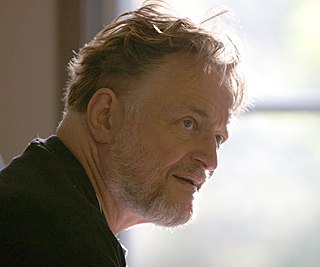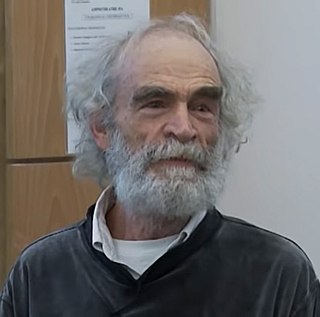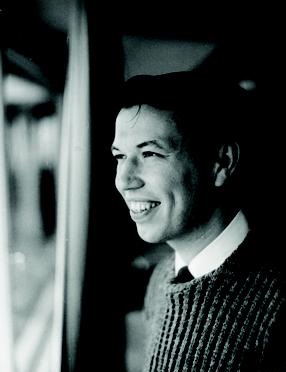
John Horton Conway was an English mathematician active in the theory of finite groups, knot theory, number theory, combinatorial game theory and coding theory. He also made contributions to many branches of recreational mathematics, most notably the invention of the cellular automaton called the Game of Life.

Geometry of numbers is the part of number theory which uses geometry for the study of algebraic numbers. Typically, a ring of algebraic integers is viewed as a lattice in and the study of these lattices provides fundamental information on algebraic numbers. The geometry of numbers was initiated by Hermann Minkowski.
In mathematics, the Leech lattice is an even unimodular lattice Λ24 in 24-dimensional Euclidean space, which is one of the best models for the kissing number problem. It was discovered by John Leech. It may also have been discovered by Ernst Witt in 1940.

In geometry, a sphere packing is an arrangement of non-overlapping spheres within a containing space. The spheres considered are usually all of identical size, and the space is usually three-dimensional Euclidean space. However, sphere packing problems can be generalised to consider unequal spheres, spaces of other dimensions or to non-Euclidean spaces such as hyperbolic space.
144 is the natural number following 143 and preceding 145.

Elwyn Ralph Berlekamp was a professor of mathematics and computer science at the University of California, Berkeley. Berlekamp was widely known for his work in computer science, coding theory and combinatorial game theory.

Mikhael Leonidovich Gromov is a Russian-French mathematician known for his work in geometry, analysis and group theory. He is a permanent member of Institut des Hautes Études Scientifiques in France and a professor of mathematics at New York University.

Grigory Aleksandrovich Margulis is a Russian-American mathematician known for his work on lattices in Lie groups, and the introduction of methods from ergodic theory into diophantine approximation. He was awarded a Fields Medal in 1978, a Wolf Prize in Mathematics in 2005, and an Abel Prize in 2020, becoming the fifth mathematician to receive the three prizes. In 1991, he joined the faculty of Yale University, where he is currently the Erastus L. De Forest Professor of Mathematics.
Robert J. McEliece was the Allen E. Puckett Professor and a professor of electrical engineering at the California Institute of Technology (Caltech) best known for his work in error-correcting coding and information theory. He was the 2004 recipient of the Claude E. Shannon Award and the 2009 recipient of the IEEE Alexander Graham Bell Medal. He was a life fellow of the IEEE and was elected to the National Academy of Engineering in 1998.
Andrew James Granville is a British mathematician, working in the field of number theory.

George Eyre Andrews is an American mathematician working in special functions, number theory, analysis and combinatorics.
In mathematics, the Barnes–Wall lattice Λ16, discovered by Eric Stephen Barnes and G. E. (Tim) Wall (Barnes & Wall (1959)), is the 16-dimensional positive-definite even integral lattice of discriminant 28 with no norm-2 vectors. It is the sublattice of the Leech lattice fixed by a certain automorphism of order 2, and is analogous to the Coxeter–Todd lattice.
14 (fourteen) is a natural number following 13 and preceding 15.

Harry Kesten was a Jewish American mathematician best known for his work in probability, most notably on random walks on groups and graphs, random matrices, branching processes, and percolation theory.

Irwin Kra is an American mathematician, who works on the function theory in complex analysis.

Italo Jose Dejter is an Argentine-born American mathematician, a retired professor of mathematics and computer science from the University of Puerto Rico, and a researcher in algebraic topology, differential topology, graph theory, coding theory and combinatorial designs. He obtained a Licentiate degree in mathematics from University of Buenos Aires in 1967, arrived at Rutgers University in 1970 by means of a Guggenheim Fellowship and obtained a Ph.D. degree in mathematics in 1975 under the supervision of Professor Ted Petrie, with support of the National Science Foundation. He was a professor at the Federal University of Santa Catarina, Brazil, from 1977 to 1984, with grants from the National Council for Scientific and Technological Development, (CNPq).
Onorato Timothy O'Meara was an American mathematician known for his work in number theory, linear groups and quadratic forms. He was provost emeritus and professor emeritus of mathematics at the University of Notre Dame.
Nolan Russell Wallach is a mathematician known for work in the representation theory of reductive algebraic groups. He is the author of the two-volume treatise Real Reductive Groups.
Kenneth C. Millett is a professor of mathematics at the University of California, Santa Barbara. His research concerns low-dimensional topology, knot theory, and the applications of knot theory to DNA structure; his initial is the "M" in the name of the HOMFLY polynomial.
Dietmar Arno Salamon is a German mathematician.










